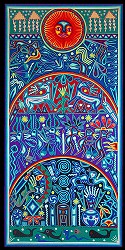 | ||||||||||
     |
 José Benítez Sánchez and the Huichol Culture The Huichol are an indigenous mountain people who live in Mexico's Sierra Madre Occidental. More than any other native culture in Mexico, the Huichol's cosmological belief system has remained intact. Due to their remote location, the Huichol avoided Western religion and subjugation by Spanish colonial rule. Huichol shaman travel 300 miles each way on a peyote pilgrimage to gather the sacred plant in Wirikúta in the state of San Luis Potosí. Shamans use peyote in sacred ceremonies in order to encounter visions. Some shamans record their visions through beaded or yarn art. Huichol artists prefer the medium of acrylic yarn or tiny colorful glass beads, both of which are pressed into a mixture of beeswax and tree resin. This art reflects the Huichol's view of the universe which co-mingles the sacred and the secular. Through their art, the Huichol honor a pantheon of nature deities. José Benítez Sánchez was born in 1938. He left home at age 15 to live with a godfather in another village. At this time, his foot became so badly infected that he sought healing from a Cora shaman. Upon being healed, he vowed to return home and become a shaman. Determined to fulfill his obligations on his path to shamanhood, Benítez left home to make the sacred journey to Wirikúta to collect the sacred peyote. When he returned, his father told him he must take certain objects with him the next time: a gourd bowl, an arrow, a candle, and a small painting of himself with his family, a deer, and a snake. Benítez did as his father suggested and made a painting from lamb's wool yarn. Upon his return, Benítez took a janitorial job at the Instituto Nacional Indigenista in Tepic. He was promoted to purchasing crafts for sale by the INI. The director, an anthropologist named Salomón Nahmad, asked Benítez to make some yarn paintings. The INI bought them. In the 1960s, Benítez became an apprentice to his cousin Ramón Medina Silva who was a shaman and an artist who fashioned decorative narratives made with yarn inspired by Huichol mythology. Benítez took the art form to a new level and began to record dreams, peyote-induced visions, and ceremonies in his works. In the 1970s, Juan Negrín who was studying the Huichol culture, promoted Benítez and his art by arranging public exhibitions. Benítez's art is exhibited in many museum collections around the world. Each of Benítez's pieces are collectors items since each one is unique, one-of-a-kind, and signed. Sacred Ceremony in Honor of Tacutsi, Goddess Moon
In the center, we see the sacred Goddess Moon in communion with the two shamans dancing and singing during the ceremony. The shamans are blessing (the Moon) with healing feathers and prayer arrows in communion with the deer horns. Snakes are saving and protecting the Moon Tacutsi. The main shaman playing the drum in the bottom right corner is in communion with the deer. He is blessing the sacred offerings with the feathers and the arrows near the sacred prayer bowls. The Eagle, who is the messenger to their gods, is protected by the red snake and purified by the fire. Withdrawn Depicting Vision in Honor to the Father Sun Táu and the Goddess Moon Tacutsi
This yarn picture depicts the sacred vision of a Huichol shaman who eats peyote and gets the dream the Huichol call Nieríka or Peyote Mandala. This Nieríka vision honors the Sun Father Táu and the Moon Goddess Tacutsi in communion with the trinity. The Huichol trinity is formed by the deer, the corn plant, and the peyote flower. The ceremony is celebrated during the day and the night in communion with the sacred eagle messenger who is protected by serpents. Blessings are performed with the healing feathers and the prayer arrows. All are purified by the Fire Tatewarí. In the artwork we can see the Nieríka or the Sacred Circle like a sacred dream in communion with the trinity (deer, corn plant, and the peyote). Offerings are honoring the sun and the moon in communion with the eagle messenger who is protected by the serpents and blessed by the healing feathers and the prayer arrows. Also, we see two shamans making the ceremony inside of a dream in communion with the three peyote flowers and the corn blessing. The blessing feathers and the arrows are purified by fire. In the top corners, we see the peyote cactus and the deer antlers protected by the serpent and blessed with the healing feathers. In the bottom corners, we see the healing feathers and the prayer arrows which are symbols of blessing. Withdrawn Feast of the Peyote
Two shamans make their offerings through gourd prayer bowls, candles, and prayer arrows in the lower left and right corners. The snake protects the prayers and offerings as they are trans-mitted to the gods. Protective snakes are believed to function as intermediaries between humans and the spirit world, instructing shamans to become healers. They are associated with the goddess of the sea who sends rain to corn fields. "Our Mother" Haramara goddess of the sea is present on the right. She is in communion with Tatewari god of fire as she sends messages of power. The stars and dots represent ancestors and are present in all yarn paintings. Withdrawn Ceremony of the Four Cardinal Points
Offerings are sent to the gods through the sacred gourd bowl, prayer arrows, and healing feathers. The horns of the deer, the corn (both of which nourish the body), and peyote (which nourishes the spirit) symbolize the Huichol's trinity. Snakes, which are believed to be interme-diaries between humans and the spirit world, protect the prayers. They instruct shamans to become healers and are associated with the goddess of the sea who sends rain to corn fields. Huicholes believe rain-drops are tiny snakes that protect corn crops. In this picture, the snakes represent the thoughts of the greatest shaman of all. Snakes send power to the shamans to speak with the spiritual world. The stars and dots represent the ancestors that are present in all yarn paintings. Withdrawn Vision of Deer with Two Heads
The shaman takes the offerings to the sacred deer Káuyumari represented by the central deer head. The offerings are sent by way of healing feathers and prayer arrows which are purified by fire, the gift from Father Sun Táu. The gift of fire is the symbol of spiritual enlightenment representing eternal light which is neces-sary to keep humans warm and protect them from evil spirits. In this ceremony the shamans give and bless the offerings in communion with the gods which represent duality. The stars and dots represent the ancestors that are present in all yarn paintings. Withdrawn Vision of the Six Directions
The shaman near the top of the picture blesses the offerings sent to Father Sun Táu along with blessings sent to "Our Mother" Haramara goddess of the oceans. Together they send rain. In the center of the picture, the shamans bless offerings and communicate with the snakes. The shamans are working in the nierika and are protected by the serpent and the sacred fire and candle. Nierika are shamanic power objects symbolizing doorways through which shamans pass into the spiritual world. The gods use nierikate as mirrors through which they can see all things. (According to Juan Negrín "The Path of Nierika: Heart, Memory and Visions" in Artes de Mexico número 75 - Arte huichol pages 80-81, nierika means metaphysical vision and place where the ancestors reveal themselves such as in yarn paintings and carved stone). Inside the nierika and beneath the group of shamans, there are three circles that represent the three worlds. Shamans bless the offerings. The hallucinogenic plant kiéri or Tree of Wind used by shamans during ritual offerings takes the offerings to heaven. Teguino is a drink made from fermented corn. Tsikúri, which resembles a God's eye, is a Huichol four-directional prayer object originally made by the Morning Star under direction of Takutsi Nakawé, the Huichol's Great Grandmother and creator goddess who started the world. It was upon the first thread cross that Takutsi Nakawé flattened a ball of mud from the bottom of the ocean to form dry ground. Protected by snakes, prayers are sent through the tsikúri, prayer arrows, healing feathers, ceremonial bowls, and drum. These figures are contained within the lower circle. Snakes, which are believed to be intermediaries between humans and the spirit world, protect the prayers. They instruct shamans to become healers and are associated with the goddess of the sea who sends rain to corn fields. Huicholes believe raindrops are tiny snakes that protect corn crops. Stars and dots represent the ancestors that are present in all yarn paintings. Withdrawn |
|||||||||
|
Cuna Cueva Home | About Us | Our Artists | Orders | Contact Us | ||||||||||





